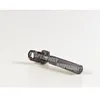A yoke shaft, also known as a coupling shaft or drive shaft, is a vital mechanical component used to transmit torque and rotation between two parts that are not aligned. Typically found in automotive, industrial machinery, and agricultural equipment, yoke shafts facilitate efficient power transfer while accommodating misalignments and reducing vibration. They are essential for applications requiring flexible connections, such as in vehicles, conveyors, and heavy-duty tools.
Understanding the technical specifications of yoke shafts is crucial for selecting the right component for your needs. Below, we detail the primary parameters in both list and table formats for clarity.
| Parameter | Description | Typical Values | Applications |
|---|---|---|---|
| Material | Type of steel or alloy used | Alloy Steel (e.g., 4140), Stainless Steel (e.g., 304) | Automotive, Industrial Machinery |
| Length (L) | Overall length of the shaft | 500 mm - 3000 mm | Conveyors, Agricultural Equipment |
| Diameter (D) | Outer diameter | 20 mm - 150 mm | Heavy-Duty Transmissions |
| Torque Capacity | Maximum torque before failure | 100 Nm - 5000 Nm | Power Transmission Systems |
| Operating Speed | Maximum RPM | Up to 5000 RPM | High-Speed Machinery |
| Weight | Mass of the shaft | 5 kg - 50 kg | Portable and Fixed Equipment |
| End Fittings | Type of connection | U-Joints, Flanges, Splined Ends | Universal Applications |
| Surface Treatment | Protective coating | Zinc Plating, Powder Coating | Corrosive Environments |
| Tolerance | Dimensional accuracy | ±0.1 mm | Precision Engineering |
| Temperature Range | Operating limits | -40°C to 120°C | Extreme Conditions |
Here are some common questions and detailed answers to help you better understand yoke shafts.
What is the primary function of a yoke shaft?
The primary function of a yoke shaft is to transmit rotational power and torque between two components that are not in a straight line, accommodating angular misalignments and reducing stress on machinery.
How do I choose the right yoke shaft for my application?
Select a yoke shaft based on parameters like torque requirements, operating speed, length, material compatibility, and environmental conditions. Consult technical specifications and, if necessary, seek expert advice to ensure optimal performance.
Can yoke shafts be customized?
Yes, yoke shafts can be customized in terms of length, diameter, material, end fittings, and surface treatments to meet specific application needs, such as unique machinery designs or harsh operating environments.
What maintenance is required for yoke shafts?
Regular maintenance includes lubrication of joints (if applicable), inspection for wear or damage, and ensuring proper alignment. Periodic checks help prevent failures and extend the shaft's lifespan.
Are yoke shafts compatible with all types of machinery?
Yoke shafts are versatile and used in various machinery, including automotive drives, industrial equipment, and agricultural tools. However, compatibility depends on specific design parameters, so always verify fitment based on torque, speed, and connection types.
What are the signs of a failing yoke shaft?
Common signs include unusual noises (e.g., clunking or vibrating), visible wear or corrosion, stiffness in rotation, and decreased performance. Immediate inspection and replacement are recommended to avoid machinery damage.
How long does a yoke shaft typically last?
The lifespan varies based on usage, maintenance, and environment. With proper care, a high-quality yoke shaft can last several years in moderate conditions, but heavy-duty applications may require more frequent replacements.
Can yoke shafts handle high-speed applications?
Yes, many yoke shafts are designed for high-speed operations, with some capable of handling up to 5000 RPM. Ensure the selected shaft meets the speed ratings specified for your application to maintain safety and efficiency.
What materials are best for corrosive environments?
For corrosive environments, stainless steel yoke shafts with protective coatings (e.g., zinc plating or powder coating) are ideal, as they offer enhanced resistance to rust and degradation.
Is installation of a yoke shaft complex?
Installation complexity depends on the application. Generally, it involves aligning the shaft with connected components and securing end fittings. For precise systems, professional installation is advised to avoid misalignment issues.


